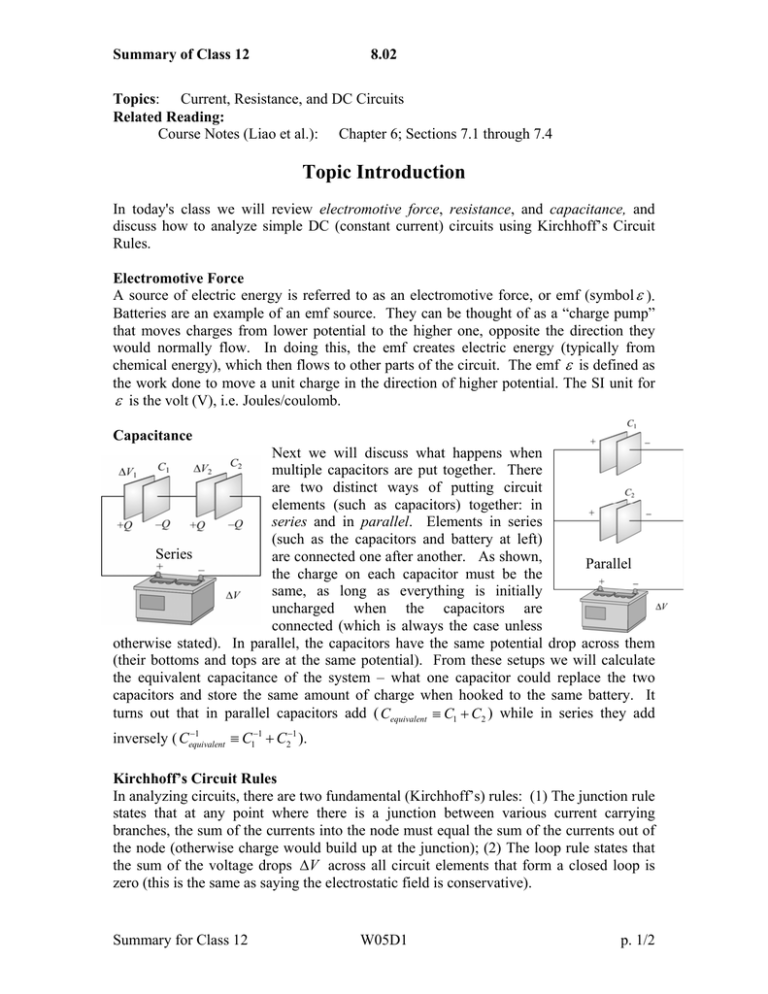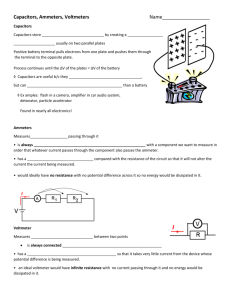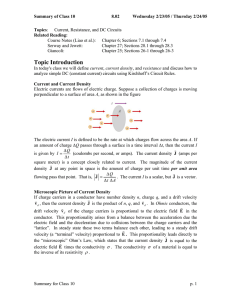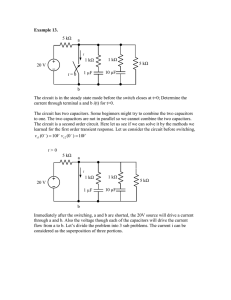Topic Introduction
advertisement

Summary of Class 12 8.02 Topics: Current, Resistance, and DC Circuits Related Reading: Course Notes (Liao et al.): Chapter 6; Sections 7.1 through 7.4 Topic Introduction In today's class we will review electromotive force, resistance, and capacitance, and discuss how to analyze simple DC (constant current) circuits using Kirchhoff’s Circuit Rules. Electromotive Force A source of electric energy is referred to as an electromotive force, or emf (symbol ε ). Batteries are an example of an emf source. They can be thought of as a “charge pump” that moves charges from lower potential to the higher one, opposite the direction they would normally flow. In doing this, the emf creates electric energy (typically from chemical energy), which then flows to other parts of the circuit. The emf ε is defined as the work done to move a unit charge in the direction of higher potential. The SI unit for ε is the volt (V), i.e. Joules/coulomb. Capacitance Next we will discuss what happens when multiple capacitors are put together. There are two distinct ways of putting circuit elements (such as capacitors) together: in series and in parallel. Elements in series (such as the capacitors and battery at left) Series are connected one after another. As shown, Parallel the charge on each capacitor must be the same, as long as everything is initially uncharged when the capacitors are connected (which is always the case unless otherwise stated). In parallel, the capacitors have the same potential drop across them (their bottoms and tops are at the same potential). From these setups we will calculate the equivalent capacitance of the system – what one capacitor could replace the two capacitors and store the same amount of charge when hooked to the same battery. It turns out that in parallel capacitors add ( Cequivalent ≡ C1 + C2 ) while in series they add −1 ≡ C1−1 + C2−1 ). inversely ( Cequivalent Kirchhoff’s Circuit Rules In analyzing circuits, there are two fundamental (Kirchhoff’s) rules: (1) The junction rule states that at any point where there is a junction between various current carrying branches, the sum of the currents into the node must equal the sum of the currents out of the node (otherwise charge would build up at the junction); (2) The loop rule states that the sum of the voltage drops ∆V across all circuit elements that form a closed loop is zero (this is the same as saying the electrostatic field is conservative). Summary for Class 12 W05D1 p. 1/2 Summary of Class 12 8.02 If you travel through a battery from the negative to the positive terminal, the voltage drop ∆V is + ε , because you are moving against the internal electric field of the battery; otherwise ∆V is - ε . If you travel through a resistor in the direction of the assumed flow of current, the voltage drop is –IR, because you are moving parallel to the electric field in the resistor; otherwise ∆V is +IR. Steps for Solving Multi-loop DC Circuits 1) Draw a circuit diagram, and label all the quantities; 2) Assign a direction to the current in each branch of the circuit--if the actual direction is opposite to what you have assumed, your result at the end will be a negative number; 3) Apply the junction rule to the junctions; 4) Apply the loop rule to the loops until the number of independent equations obtained is the same as the number of unknowns. Important Equations G Relation between J and I: Microscopic Ohm’s Law: Macroscopic Ohm’s Law: Resistance of a conductor with resistivity ρ , cross-sectional area A, and length l: Resistors in series: G G I = ∫∫ J ⋅ d A G G G J = σ E = E/ ρ V = IR R=ρ l / A Req = R1 + R2 + ⋅⋅⋅ Resistors in parallel: 1 1 1 = + + ⋅⋅⋅ Req R1 R2 Capacitors in Series: 1 1 1 ≡ + + ⋅⋅⋅ Ceq C1 C2 Capacitors in Parallel: Ceq ≡ C1 + C2 + ⋅⋅⋅ P = ∆V I Power: Summary for Class 12 W05D1 p. 2/2







